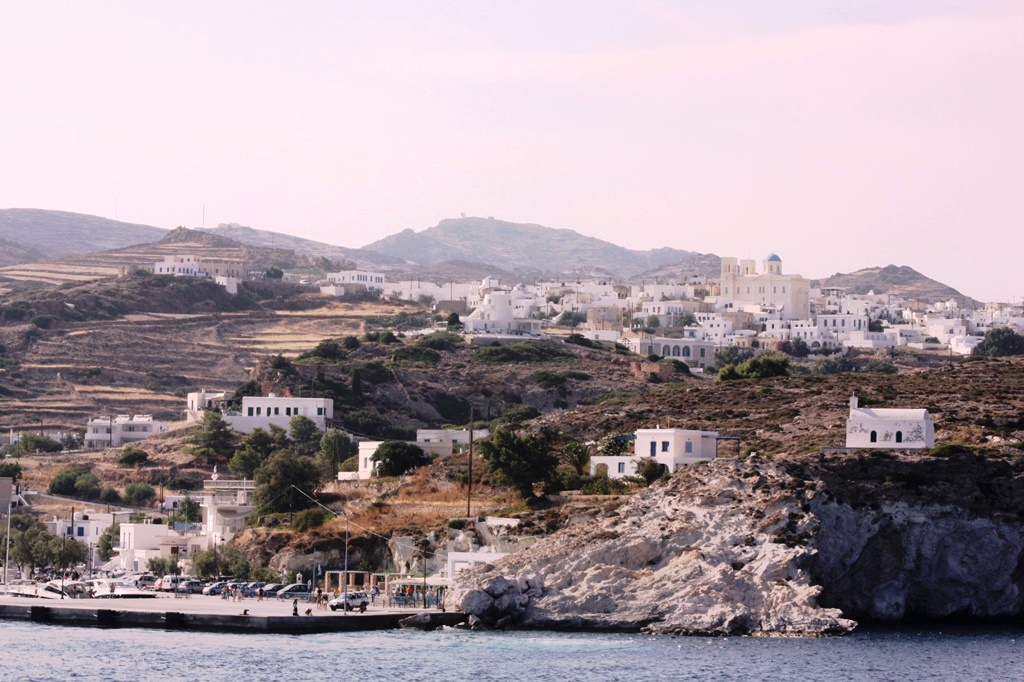Information
"My Kimolos, my heaven"!
That's the way they think the people who love Kimolos, a beautiful island, very close to Milos.
You can go by ship to Kimolos, or by the HIGH SPEED ferries until Milos which is daily linked to Kimolos.
As you arrive to its port, Psathi, you can see Kimolos appears all white as a chalk. Kimolos not only has a big variety of stones. but it also has a big variety of flora and fauna. There you can see the Mediterranean seal, which swims in the deep blue sea and gives birth to its offspring in the caves of the island. The herons and other migratory birds find shelter to Kimolos, during the winter, in Aliki.
Kimolos, picturesque and traditional, with cobbled alleys, washed white churches, beautiful and calm beaches which they challenge you to discover them and be charmed as everyone who visit this island.
Chorio, the capital of the island , is in a 1km distance from Psathi, the port of the island.
 Chorio extends around the core of the castle, which is constituted by the residential parts of Inside Castle and Outside Castle, which are connected with four paths called the Portares.
Chorio extends around the core of the castle, which is constituted by the residential parts of Inside Castle and Outside Castle, which are connected with four paths called the Portares.
A tour around the castle with the narrow and uphill alleys and the old mansions is certainly a must.
Chorio is built to the foot of the mountain Xaplovouni, so it is protected by the fierce northern winds.
The white houses with the blue windows and their yards will make you travel with your mind to the past years. There are many churches on the island and as historical resources state, during the Turkish rule there was a specific order from the Sultan and the churches of Kimolos were the only to retain and ring their bells.
The Cathedral of the island, Panagia Odigitria, is celebrated on 21st of November and it is a national festivity for Kimolos. The icon of Panagia was created in 15th century and was curried to Kimolos by Sifnians who colonized the island.
In the castle there is the oldest church of the island, The Birth of Christ (1592) and was built by a priest Ioannis Ramfos as it stated on a marble inscription.
The access to the beaches can be achieved by roads, on boats or by fast sailing taxi. There are also beaches which are not accessible by land but it is wroth to approach them by sea.
Considering the weather you can choose from a variety of beaches to go. The beaches of Aliki and Bonatsa are considered to be a natural sequence, as well as the beach of Kalamitsi, are the most ideal places in any weather even during the summer gusts. Grate beaches with delicate sand. Ai Giorgis beach in Prassa with white sand which is unique, Livadaki, Klima, Rema and Psathi, are offered for swimming and sun-bathing when the weather is right. Soufi, Monastiria, Ormos of Athina, Kastro in the west and the island Poliegos offer grate sandy beaches. Beach with great tourist interest are Ellinika, in the west of the island, where a dead city with tombs and pots fragments of geometrical and ancient years was found, which are kept in the museum of Kimolos. In Asprogremna, you can see the ruins of Kimolos Ancient City, which like Ellinika, was found a sepulchral column, which is considered to be the most ancient one since historic times. At Vromolimni, where the access can be achieved on a boat from Psathi, or riding a donkey from Chorio, there is the biggest out of a row of caves carved on the rock and is divided into inside and outside cave.
It is worth to visit the Folklore and Naval museum of Kimolos.
You will easily find rooms to rent, taverns and cafes. Comparing with other places rooms to rent and taverns are not so many, but they are approachable, clean, familiar and ready to welcome you.
The warmth of the local people, who they offer you the traditional hospitality and make you want to com back again.
Of course you should taste the local dishes as ladenia (dough or bread with tomato, onions and olive), xino (cheese), manouri, cracker with schinokokos, paste and tirenies as well as the domestic honey.
As all the Cycladians, the people of Kimolos, have very strong religious feeling, something that you can realize from the local festivities, in which everyone participate and make a pure insular feast.
For Kimolos Community
Authors of texts:
Despina Athanasiadou - Ventouri and Georgios Ant. Ventouris
|
|
|
||||||||||||||||||||||||||||||||||||||||||||||||||||||||||
|
|
||||||||||||||||||||||||||||||||||||||||||||||||||||||||||









